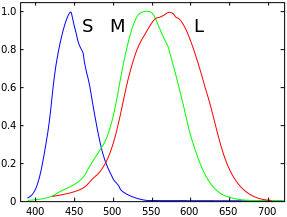
A | B | C | D | E | F | G | H | CH | I | J | K | L | M | N | O | P | Q | R | S | T | U | V | W | X | Y | Z | 0 | 1 | 2 | 3 | 4 | 5 | 6 | 7 | 8 | 9

LMS (long, medium, short), is a color space which represents the response of the three types of cones of the human eye, named for their responsivity (sensitivity) peaks at long, medium, and short wavelengths.
The numerical range is generally not specified, except that the lower end is generally bounded by zero. It is common to use the LMS color space when performing chromatic adaptation (estimating the appearance of a sample under a different illuminant). It's also useful in the study of color blindness, when one or more cone types are defective.
Definition
The cone response functions are the color matching functions for the LMS color space. The chromaticity coordinates (L, M, S) for a spectral distribution are defined as:
The cone response functions are normalized to have their maxima equal to unity.
XYZ to LMS
Typically, colors to be adapted chromatically will be specified in a color space other than LMS (e.g. sRGB). The chromatic adaptation matrix in the diagonal von Kries transform method, however, operates on tristimulus values in the LMS color space. Since colors in most colorspaces can be transformed to the XYZ color space, only one additional transformation matrix is required for any color space to be adapted chromatically: to transform colors from the XYZ color space to the LMS color space.[3]
In addition, many color adaption methods, or color appearance models (CAMs), run a von Kries-style diagonal matrix transform in a slightly modified, LMS-like, space instead. They may refer to it simply as LMS, as RGB, or as ργβ. The following text uses the "RGB" naming, but do note that the resulting space has nothing to do with the additive color model called RGB.[3]
The chromatic adaptation transform (CAT) matrices for some CAMs in terms of CIEXYZ coordinates are presented here. The matrices, in conjunction with the XYZ data defined for the standard observer, implicitly define a "cone" response for each cell type.
Notes:
- All tristimulus values are normally calculated using the CIE 1931 2° standard colorimetric observer.[3]
- Unless specified otherwise, the CAT matrices are normalized (the elements in a row add up to 1) so the tristimulus values for an equal-energy illuminant (X=Y=Z), like CIE Illuminant E, produce equal LMS values.[3]
Hunt, RLAB
This article is missing information about how the HPE matrix was derived – looks like the most "physiological" of the XYZ bunch, but where's the data?. (October 2021) |
The Hunt and RLAB color appearance models use the Hunt-Pointer-Estevez transformation matrix (MHPE) for conversion from CIE XYZ to LMS.[4][5][6] This is the transformation matrix which was originally used in conjunction with the von Kries transform method, and is therefore also called von Kries transformation matrix (MvonKries).
Bradford's spectrally sharpened matrix (LLAB, CIECAM97s)
The original CIECAM97s color appearance model uses the Bradford transformation matrix (MBFD) (as does the LLAB color appearance model).[3] This is a “spectrally sharpened” transformation matrix (i.e. the L and M cone response curves are narrower and more distinct from each other). The Bradford transformation matrix was supposed to work in conjunction with a modified von Kries transform method which introduced a small non-linearity in the S (blue) channel. However, outside of CIECAM97s and LLAB this is often neglected and the Bradford transformation matrix is used in conjunction with the linear von Kries transform method, explicitly so in ICC profiles.[8]
A "spectrally sharpened" matrix is believed to improve chromatic adaptation especially for blue colors, but does not work as a real cone-describing LMS space for later human vision processing. Although the outputs are called "LMS" in the original LLAB incarnation, CIECAM97s uses a different "RGB" name to highlight that this space does not really reflect cone cells; hence the different names here.
LLAB proceeds by taking the post-adaptation XYZ values and performing a CIELAB-like treatment to get the visual correlates. On the other hand, CIECAM97s takes the post-adaptation XYZ value back into the Hunt LMS space, and works from there to model the vision system's calculation of color properties.
Later CIECAMs
A revised version of CIECAM97s switches back to a linear transform method and introduces a corresponding transformation matrix (MCAT97s):[9]
Antropológia
Aplikované vedy
Bibliometria
Dejiny vedy
Encyklopédie
Filozofia vedy
Forenzné vedy
Humanitné vedy
Knižničná veda
Kryogenika
Kryptológia
Kulturológia
Literárna veda
Medzidisciplinárne oblasti
Metódy kvantitatívnej analýzy
Metavedy
Metodika
Text je dostupný za podmienok Creative
Commons Attribution/Share-Alike License 3.0 Unported; prípadne za ďalších
podmienok.
Podrobnejšie informácie nájdete na stránke Podmienky
použitia.
www.astronomia.sk | www.biologia.sk | www.botanika.sk | www.dejiny.sk | www.economy.sk | www.elektrotechnika.sk | www.estetika.sk | www.farmakologia.sk | www.filozofia.sk | Fyzika | www.futurologia.sk | www.genetika.sk | www.chemia.sk | www.lingvistika.sk | www.politologia.sk | www.psychologia.sk | www.sexuologia.sk | www.sociologia.sk | www.veda.sk I www.zoologia.sk








